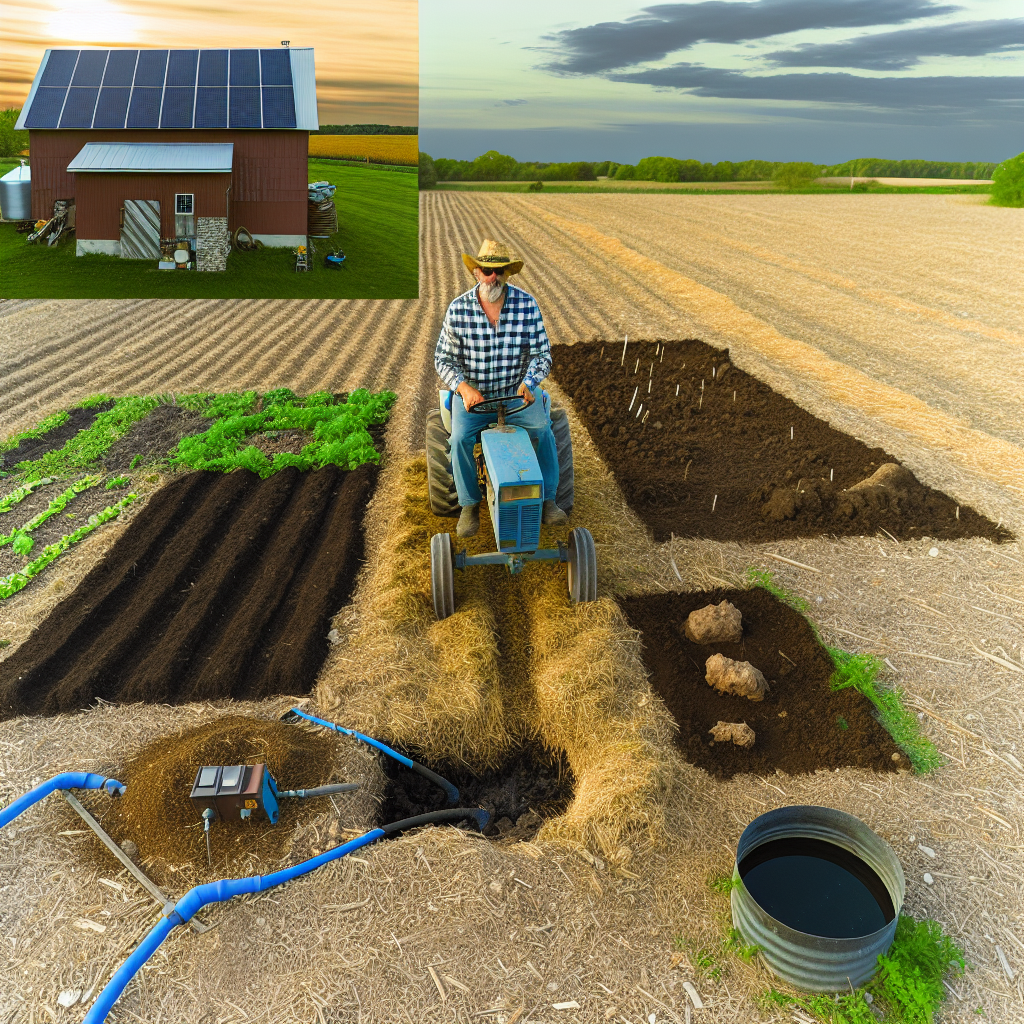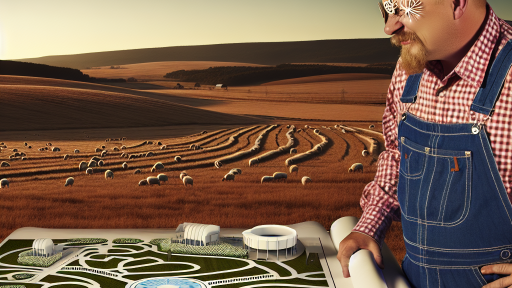Introduction to Sustainable Farm Layout
Importance of Sustainable Farming
Sustainable farming plays a crucial role in modern agriculture.
It emphasizes environmental health and economical viability.
Furthermore, it promotes social equity among farming communities.
Benefits of a Thoughtful Farm Layout
A well-planned farm layout can boost productivity significantly.
It enhances crop rotation and soil health over time.
Moreover, it allows better management of water resources.
Farmers can reduce input costs through efficient layouts.
In addition, a sustainable layout supports local biodiversity.
Strategies for Implementing Sustainable Layouts
Implementing sustainable techniques requires careful planning.
Farmers should consider the local ecosystem and climate.
Additionally, they must evaluate their specific crop needs.
Engaging with local agricultural experts can provide valuable insights.
Environmental Impact
Sustainable layouts help minimize negative environmental impacts.
They reduce soil erosion and promote water retention.
Consequently, healthier soils lead to more robust crop yields.
Transform Your Agribusiness
Unlock your farm's potential with expert advice tailored to your needs. Get actionable steps that drive real results.
Get StartedSuch practices lower the reliance on chemical fertilizers.
Community and Economic Benefits
Eco-friendly farming methods enhance local economies.
They create job opportunities in sustainable agriculture.
Furthermore, these farms often attract eco-conscious consumers.
As a result, farmers can access new markets and revenue streams.
Principles of Sustainable Farming
Understanding Ecological Balance
Sustainable farming seeks to maintain ecological balance.
It enhances biodiversity and preserves soil health.
Moreover, it reduces negative impacts on the environment.
Utilizing Renewable Resources
Farmers prioritize renewable resources in sustainable practices.
This approach reduces dependency on non-renewable inputs.
For example, crop rotation enhances soil fertility over time.
Additionally, cover crops improve soil structure and health.
Emphasizing Soil Health
Healthy soil is crucial for successful sustainable farming.
Farmers employ no-till practices to prevent soil erosion.
Furthermore, they incorporate compost to enrich soil nutrients.
Regular soil testing helps tailor amendments effectively.
Water Conservation Techniques
Efficient water management is vital in sustainable agriculture.
Farmers implement drip irrigation to minimize water waste.
Rainwater harvesting systems are also effective solutions.
These methods enhance crop resilience during drought conditions.
Crop Diversity and Rotation
Diverse cropping systems promote ecological stability.
By rotating crops, farmers disrupt pest cycles effectively.
This practice protects against soil nutrient depletion.
Additionally, it enhances overall farm resilience.
Showcase Your Farming Business
Publish your professional farming services profile on our blog for a one-time fee of $200 and reach a dedicated audience of farmers and agribusiness owners.
Publish Your ProfileIntegrating Livestock in Farming Systems
Integrating livestock offers numerous benefits.
Animals contribute natural fertilizers to crop systems.
Furthermore, they assist in controlling weeds and pests.
This holistic approach promotes nutrient cycling on farms.
Community Engagement and Education
Community involvement is key to successful sustainable farming.
Farmers share knowledge through workshops and training sessions.
Building local networks enhances resource-sharing opportunities.
Ultimately, informed communities can make better agricultural choices.
Site Assessment for Sustainable Farms: Evaluating Land and Resources
Understanding Site Assessment
A site assessment forms the foundation of sustainable agriculture.
This process evaluates the land’s characteristics and resources.
Farmers gain insights into soil, water, and ecological conditions.
Evaluating Soil Quality
Soil analysis identifies nutrient levels and pH balance.
Organic matter content is crucial for healthy soil ecosystems.
Farmers should conduct regular soil tests for optimal management.
Assessing Water Resources
Water availability directly impacts sustainable farming practices.
Farmers must evaluate the quality and quantity of local water sources.
Considerations should include rainfall patterns and irrigation needs.
Using water-saving technologies can enhance resource efficiency.
Surveying the Landscape
Understanding the topography affects farm layout decisions.
Farmers should identify slopes and drainage patterns on their land.
Such factors influence erosion control and crop placement.
Examining Local Biodiversity
Biodiversity assessment helps maintain ecological stability.
This involves recognizing existing flora and fauna on the farm.
Farmers should consider planting native species to enhance ecosystems.
Identifying Legal and Regulatory Requirements
Local laws and regulations affect sustainable farming practices.
Farmers must be aware of zoning, permits, and environmental regulations.
Compliance ensures that farming operations are sustainable and legal.
Engaging with the Community
Community engagement fosters support for sustainable practices.
Farmers should communicate with local organizations and neighbors.
Collaboration can lead to shared resources and knowledge exchange.
Discover More: No-Till Farming To Enhance Soil Regeneration
Designing Crop Rotation Systems
Importance of Crop Rotation
Crop rotation enhances soil health and fertility.
It prevents nutrient depletion caused by continuous monoculture.
Additionally, rotating crops disrupts pest and disease cycles.
This practice promotes biodiversity in farming systems.
Key Principles of Crop Rotation
Rotate crops with different families each season.
For instance, legumes improve nitrogen levels in the soil.
Follow legumes with heavy feeders like corn or tomatoes.
Consider the timing of planting and harvesting for each crop.
Creating a Crop Rotation Plan
Start by mapping out your available arable land.
Showcase Your Farming Business
Publish your professional farming services profile on our blog for a one-time fee of $200 and reach a dedicated audience of farmers and agribusiness owners.
Publish Your ProfileIdentify the crops you want to grow based on market demand.
Develop an annual schedule that includes at least three different crop types.
Ensure each crop has a specific growing season to avoid conflicts.
Monitoring and Adjusting the Plan
Regularly assess soil health and crop performance.
Make adjustments to your rotation based on these observations.
Consider factors like weather conditions and pest populations.
Incorporate cover crops in your rotation to enhance soil quality.
Benefits of Diverse Crop Systems
Diverse crop systems increase the resilience of your farm.
They can reduce reliance on chemical fertilizers and pesticides.
Moreover, they create a richer ecosystem for beneficial insects.
This approach strengthens the overall sustainability of agriculture.
You Might Also Like: Soil Microbes And Their Role In Regeneration
Integrating Livestock into Farm Layout
Benefits of Mixed Farming Systems
Mixed farming combines crop production with livestock raising.
This approach enhances sustainability on the farm.
It optimizes resource use while promoting ecological balance.
Soil Health Improvement
Livestock contribute organic matter to the soil through manure.
Manure acts as a natural fertilizer for crops.
Additionally, this practice enhances soil fertility and structure.
Healthy soil leads to better water retention and nutrient cycling.
Diverse Income Streams
Integrating livestock creates multiple sources of income.
Crops and livestock can provide complementary revenue.
This diversification reduces economic risks for farmers.
In case of crop failure, livestock can offer financial stability.
Enhanced Pest Control
Livestock can naturally manage pests in the agricultural ecosystem.
Chickens, for example, consume insects and weeds effectively.
This helps minimize the need for chemical pesticides.
Ultimately, this practice promotes a healthier farm environment.
Improved Biodiversity
Integrating various species enhances farm biodiversity.
This biodiversity supports resilience against diseases and pests.
It also contributes to ecological stability on the farm.
Farmers can enjoy a richer farm ecosystem while increasing productivity.
Efficient Resource Utilization
Mixed farming maximizes the use of available resources.
Livestock can graze on fields after crops are harvested.
This practice helps reduce waste and increases productivity.
Furthermore, cover crops can benefit from the manure supplied by livestock.
Community Engagement
Integrating livestock fosters connections within local communities.
Farmers can share resources and knowledge in mixed farming systems.
This collaboration strengthens local agricultural networks.
As a result, communities become more resilient and sustainable.
You Might Also Like: Maximizing Soil Health with Effective Crop Rotation
Showcase Your Farming Business
Publish your professional farming services profile on our blog for a one-time fee of $200 and reach a dedicated audience of farmers and agribusiness owners.
Publish Your ProfileCreating Microclimates
Understanding Microclimates
Microclimates are small areas with distinct climatic conditions.
They can vary significantly from their surrounding environments.
This variation affects plant growth and crop yields.
Importance of Microclimates in Farming
Utilizing microclimates can enhance agricultural productivity.
They enable farmers to optimize environmental conditions effectively.
Specific crops can thrive in tailored environments.
Techniques for Creating Microclimates
Planting windbreaks is an effective method for creating microclimates.
Windbreaks reduce wind speed and create sheltered areas.
These shelters protect delicate plants from harsh weather.
Another technique involves using shade structures.
Shade structures can lower temperatures and reduce heat stress.
They help maintain moisture levels in the soil.
Water features also contribute to microclimate creation.
Ponds and streams increase humidity levels in their proximity.
This moisture benefits plants, especially during dry spells.
Best Practices for Maintaining Microclimates
Regular monitoring is essential for sustaining microclimates.
Farmers should track temperature, humidity, and light levels.
This information enables timely adjustments to farming practices.
Additionally, practicing crop rotation enhances soil health.
Crop rotation diversifies nutrients available in the soil.
Healthy soil supports plants better in variable microclimate conditions.
Integrating native plants into the farm layout fosters biodiversity.
Natives stabilize local ecosystems and enhance resilience.
They also attract beneficial insects and pollinators.
Learn More: Integrating Renewable Energy Into Farm Planning Designs

Implementing Water Management Strategies
Conservation Techniques
Water conservation is essential for sustainable farming.
Farmers can adopt various methods to reduce water usage.
Implementing rainwater harvesting significantly enhances water availability.
This technique involves collecting and storing rainwater for later use.
Using mulching helps in reducing evaporation from the soil.
Moreover, it prevents soil erosion, contributing to better soil health.
Cover crops also play a critical role in water conservation.
They improve soil structure and enhance water infiltration rates.
Utilizing drip irrigation systems optimizes water delivery to plants.
This method targets root zones directly, minimizing waste.
Efficiency in Water Use
Maximizing water efficiency is vital for sustainable agriculture.
Farmers should regularly test soil moisture levels.
This practice helps determine the optimal irrigation schedule.
Implementing smart irrigation technology can further enhance efficiency.
These systems adjust watering based on weather conditions.
Showcase Your Farming Business
Publish your professional farming services profile on our blog for a one-time fee of $200 and reach a dedicated audience of farmers and agribusiness owners.
Publish Your ProfileCrop rotation practices also conserve water in farming systems.
Different crops have varying water needs, allowing for better resource use.
Training staff on water-efficient practices boosts overall productivity.
Regularly updating irrigation infrastructure ensures peak performance.
Education and Community Involvement
Communities play a crucial role in water management strategies.
Farmers should engage in local workshops and training programs.
Sharing knowledge about water conservation fosters collaborative efforts.
Partnerships with local governments can lead to better resource allocation.
Farmers can also participate in water conservation initiatives.
These programs provide funding and support for innovative practices.
Engaging customers in sustainable practices strengthens market demand.
Community education increases awareness about water issues.
Encouraging local businesses to adopt sustainable water practices creates synergy.
Utilizing Permaculture Principles
Understanding Permaculture
Permaculture focuses on sustainable land use design.
This method aims for agricultural resilience.
It integrates human needs with natural ecosystems.
Key Principles of Permaculture
Start with the observation of natural patterns.
Design around energy flow to maximize efficiency.
Implement diversity to enhance ecosystem health.
Build soil fertility through organic practices.
Utilize renewable resources wherever possible.
Implementing Permaculture Techniques
Zone planning optimizes space and resource use.
Plant guilds create beneficial relationships among plants.
Water management techniques ensure efficient use of water.
Designing for Resilience
Focus on creating systems that resist environmental stress.
Incorporate holistic management practices.
Utilize companion planting to promote plant health.
Enhance biodiversity to build ecosystem resilience.
Case Studies of Successful Implementation
Green Valley Farm reduced water use by 30% using permaculture.
Sunny Acres integrated chickens into crop rotations effectively.
Riverbend Community implemented a successful rainwater collection system.
Best Practices for Sustainable Farm Layout
Follow natural contours to manage water runoff.
Create windbreaks to protect crops from harsh winds.
Utilize cover crops to improve soil health.
Incorporate composting to reduce waste and enhance fertility.
Best Practices for Soil Health Management
Cover Crops
Cover crops are essential for enhancing soil health.
They provide numerous benefits, including erosion control.
Additionally, these crops improve soil structure and fertility.
Farmers can choose from various cover crop species.
Legumes, such as clover and vetch, fix nitrogen in the soil.
Showcase Your Farming Business
Publish your professional farming services profile on our blog for a one-time fee of $200 and reach a dedicated audience of farmers and agribusiness owners.
Publish Your ProfileGrasses like rye create biomass that adds organic matter.
Furthermore, cover crops can suppress weeds effectively.
It’s crucial to select cover crops that match your climate.
Each crop should be chosen based on the cropping system.
Incorporating cover crops strengthens resilience against pests.
Moreover, they enhance the soil’s ability to retain moisture.
Minimal Tillage
Minimal tillage is a key practice for sustainable farming.
This technique preserves soil structure and health.
It reduces the disruption of soil organisms significantly.
Consequently, soil fertility improves over time.
Farmers can implement no-till or reduced-till methods.
Adopting minimal tillage helps reduce erosion risks.
This practice also enhances water retention in the soil.
Moreover, it can increase carbon sequestration.
Transitioning to minimal tillage requires careful planning.
Farmers should assess their current systems first.
Training and workshops can provide valuable insights.
Collaboration with local agricultural agencies is also beneficial.
Ultimately, minimal tillage supports long-term sustainability.
Community Engagement and Education: Building Local Support for Sustainable Practices
Importance of Community Involvement
Community involvement is essential for successful sustainable farming.
Engaging local residents fosters a sense of ownership.
This ensures long-term commitment to sustainable practices.
Education Initiatives
Education plays a crucial role in promoting sustainability.
Workshops and seminars can raise awareness about methods.
Informative sessions can help community members understand benefits.
Schools can incorporate agricultural education into their curriculum.
This encourages future generations to value sustainable practices.
Collaboration with Local Organizations
Partnering with local organizations can enhance community efforts.
Non-profits can provide resources and expertise in sustainable farming.
Collaboration may lead to joint initiatives that reinforce impact.
This united approach strengthens community ties and support.
Creating Sustainable Community Programs
Developing community programs encourages participation.
Farmers’ markets can promote local produce and sustainable methods.
Urban gardens can provide hands-on experience in sustainable practices.
Community-supported agriculture (CSA) programs offer fresh produce directly.
These programs build awareness and encourage sustainable consumption.
Feedback and Continuous Improvement
Gathering feedback from community members is vital.
This helps identify challenges and areas for improvement.
Regular surveys can assess the effectiveness of programs.
Adjusting strategies according to feedback fosters community trust.
Showcase Your Farming Business
Publish your professional farming services profile on our blog for a one-time fee of $200 and reach a dedicated audience of farmers and agribusiness owners.
Publish Your ProfileIt also demonstrates a commitment to community needs.
Additional Resources
Sustainable Agriculture Programs | NIFA
How to encourage farmers to adopt sustainable agriculture | IFPRI




